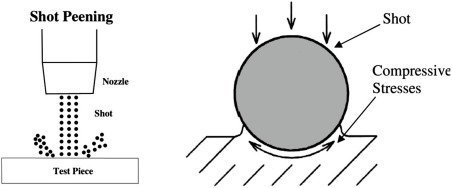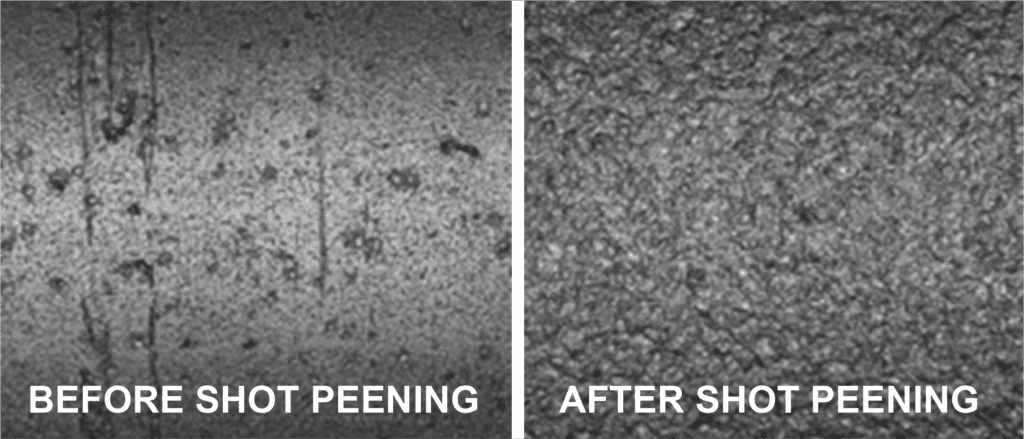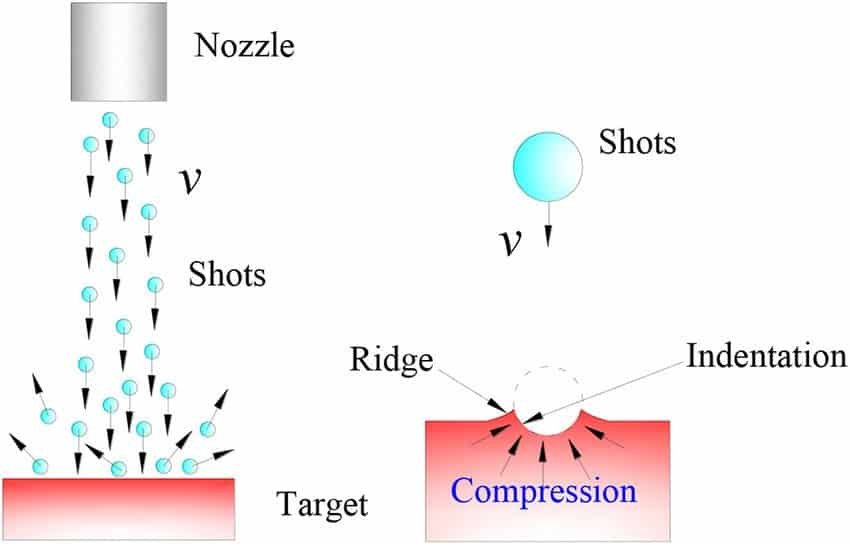
Shot peening has become one of the most reliable surface treatment processes for modern industries. From aerospace turbine blades to automotive gears, this process helps extend the service life of components by making them stronger and more resistant to fatigue. Unlike coating or chemical methods, shot peening works at the microstructural level, using small spherical particles—most commonly steel shots—to reshape the surface of a material.
Shot peening is a cold working process that bombards a metal surface with spherical media (such as steel shots) to create compressive stress, which improves fatigue life, prevents crack growth, and enhances durability.
If you only know shot peening as a cleaning process, you might be underestimating its true power. While similar to shot blasting in appearance, the goals are very different: blasting prepares or cleans a surface, while peening enhances performance. This article will walk you through everything you need to know about shot peening.
In the following sections, you will learn what shot peening is, how the process works, the types of media and machines used, its difference from shot blasting, the applications across industries, and the key benefits that make it one of the most cost-effective strengthening methods today.
Table of Contents
What is Shot Peening?
Shot peening is not simply a surface cleaning process. It is a carefully controlled cold working technique that introduces beneficial residual stresses into the surface of metals. These stresses help the material withstand repeated loading cycles without failure.
Shot peening is defined as a cold working process in which spherical media strike a surface to introduce beneficial compressive residual stresses.

When spherical particles hit the surface, they create microscopic dents. These dents overlap and compress the surface layer of the material. The resulting compressive stress counters the tensile stresses that typically cause cracks, corrosion, or fatigue. By modifying the surface layer, the internal structure of the metal becomes more resilient without changing its overall dimensions.
Shot peening is a science-driven process that ensures durability and reliability in critical metal components.
How Does Shot Peening Work?
The working principle of shot peening may seem simple, but in practice it requires precise control of parameters such as shot velocity, size, coverage, and hardness.
During shot peening, controlled impacts create tiny dents on the surface, which overlap to form a continuous compressive stress layer that delays fatigue cracks.

Shot peening intensity is often measured using the Almen strip test. In this method, a thin steel strip is exposed to the peening process, and its curvature indicates the stress level applied. Operators also monitor coverage, ensuring that every area of the surface has been properly impacted. If intensity or coverage is inconsistent, the treatment will not achieve its full benefit.
The effectiveness of shot peening lies in precision — carefully controlled impacts turn surface weaknesses into strengths.
Media Used in Shot Peening?
The choice of media is one of the most critical decisions in any shot peening process. Different industries and components require different media depending on factors like hardness, finish, cost, and environmental safety. While steel shot is the most commonly used abrasive, other options such as glass beads, ceramic beads, and even specialized alternatives are also widely applied.
The most common media for shot peening are steel shots, glass beads, and ceramic beads, each selected based on the required balance between durability, surface finish, and application needs.

- Steel Shot: High-carbon or low-carbon steel shots are the industry standard. They are durable, recyclable, and capable of inducing strong compressive stresses. Best suited for heavy-duty applications such as automotive and aerospace parts.
- Glass Beads: Softer than steel, they produce a smoother finish with minimal surface damage. Commonly used in aerospace and medical industries where surface integrity is critical.
- Ceramic Beads: Extremely hard and resistant to heat and corrosion. Ideal for high-performance applications like turbines, implants, and precision components.
- Other Media: Stainless steel shots (304/430) are used where corrosion resistance is needed. Occasionally, plastic or walnut shell media may be applied for delicate peening tasks, though rarely in high-load industries.
Comparison Table: Media Used in Shot Peening
| Media Type | Key Characteristics | Surface Effect | Typical Applications | Cost & Durability |
| Steel Shot | Spherical, high strength, recyclable | Creates strong compressive stresses, moderate finish | Automotive gears, springs, aerospace structural parts | High durability, cost-effective |
| Glass Beads | Lightweight, softer impact | Smooth, bright finish with minimal damage | Aerospace components, medical implants, delicate instruments | Moderate cost, recyclable but less durable |
| Ceramic Beads | Very hard, heat & corrosion resistant | Excellent compressive stress with fine finish | Turbines, high-performance alloys, critical aerospace parts | Higher cost, very durable |
| Stainless Steel Shot (304/430) | Corrosion resistant, reusable | Strong compressive stresses, no contamination | Food & medical equipment, stainless steel parts | Higher cost, long service life |
| Other Media (Plastic, Walnut Shells) | Low-density, non-metallic | Gentle peening with minimal stress | Electronics, precision instruments | Low cost, limited durability |
No single media fits all applications. Steel shot dominates the industry due to its balance of cost, strength, and recyclability, but glass and ceramic beads are indispensable for specialized, high-precision applications. Choosing the right media ensures both performance and cost efficiency in shot peening operations.
What is a Shot Peening Machine?
Without specialized machines, shot peening would be inconsistent and unreliable. The equipment ensures that shots strike with the right velocity, angle, and coverage.
A shot peening machine propels media using air blast or centrifugal wheels, ensuring precise control of coverage and intensity.

- Air Blast Machines: Use compressed air to accelerate shots. Highly flexible and suitable for complex geometries or small-batch jobs.
- Wheel Blast Machines: Use centrifugal wheels to propel shots at high speed. Best for large-volume production and heavy components.
- Monitoring Systems: Advanced machines integrate sensors to ensure correct Almen intensity and coverage, guaranteeing process repeatability.
The machine is the heart of shot peening—without control, the process cannot deliver its benefits.
Shot Peening vs Shot Blasting: What’s the Difference?
Shot peening and shot blasting are two industrial processes that often get confused. At first glance, both involve propelling small particles at high velocity onto a surface. However, the objectives, process mechanisms, and outcomes are entirely different. Understanding these differences is essential for engineers, quality managers, and procurement teams when choosing the right surface treatment.
Shot blasting removes rust, scale, and coatings to clean and prepare a surface, while shot peening strengthens metals by inducing beneficial compressive stresses that improve fatigue life and prevent cracks.

- Shot blasting is primarily a cleaning and preparation process. It removes impurities, corrosion, or old coatings and creates a rough profile that improves paint or coating adhesion.
- Shot peening, on the other hand, is a strengthening process. It uses spherical media to create compressive stress layers that improve fatigue strength and durability without removing significant material.
- While both use similar equipment and sometimes the same media, their purpose, control methods, and end results are very different.
Comparison Table: Shot Peening vs Shot Blasting
| Feature / Aspect | Shot Blasting | Shot Peening |
| Primary Purpose | Cleaning and surface preparation | Strengthening and fatigue resistance |
| Process Mechanism | Abrasive impact removes rust, scale, paint, or coatings | Controlled spherical media impact induces compressive stress |
| Surface Result | Rough, clean surface ready for coatings | Strengthened surface with improved fatigue performance |
| Media Used | Steel grit, steel shot, garnet, aluminum oxide | Steel shots, glass beads, ceramic beads |
| Applications | Shipbuilding, construction, foundries, coating prep | Aerospace turbine blades, automotive springs, energy components |
| End Benefit | Better coating adhesion, corrosion resistance | Extended service life, crack prevention, higher durability |
| Process Control | Less precise, focused on coverage | Highly controlled (Almen intensity, coverage measurement) |
Although shot blasting and shot peening are distinct, they are not mutually exclusive. In many industries, the two processes are used together. A component may first undergo shot blasting to remove oxide scale, rust, or old coatings, leaving a clean surface. Next, it may be subjected to shot peening, which adds beneficial compressive stresses that improve fatigue resistance.
This combined approach is common in aerospace and automotive manufacturing. For example, aircraft turbine blades are blasted to remove oxides and then peened to extend fatigue life. Automotive gears and suspension springs may be blasted for surface preparation before peening strengthens them against repeated stress cycles.
The choice depends on the end goal:
- If the requirement is surface cleanliness and adhesion, blasting alone is sufficient.
- If the requirement is durability and crack resistance, peening is the right process.
- If both are critical, blasting and peening can be applied in sequence for maximum benefit.
In short, shot blasting prepares the surface, while shot peening prepares the component for long-term performance. They are complementary processes that, when applied correctly, maximize both surface quality and structural strength.
Steel Shot vs Steel Grit in Shot Peening: Which Should You Choose?
When discussing media for shot peening, most people immediately think of steel shots. Their round shape and durability make them the industry standard. However, some engineers and buyers wonder: Can steel grit also be used for shot peening? The answer is more nuanced than a simple yes or no. Understanding the differences between steel shot and steel grit is essential for selecting the right media.
Steel shot is the preferred media for shot peening due to its spherical shape, which delivers uniform compressive stresses. Steel grit, being angular, is generally used for blasting rather than peening.
- Steel Shot: Perfectly spherical particles that strike the surface evenly. This uniform impact is what makes shot peening effective. It creates compressive stress without cutting or damaging the surface.
- Steel Grit: Angular particles designed for cutting and abrasion. They remove rust, paint, and scale efficiently, but their sharp edges do not create the uniform dimpling effect required for controlled compressive stresses.
- Can Steel Grit Be Used for Shot Peening? In rare cases, grit may be used for hybrid processes, but it is not recommended for true shot peening. Standards such as SAE J444 and AMS-S-13165 specifically define spherical media (shot) as the correct material for peening.
Comparison Table: Steel Shot vs Steel Grit in Shot Peening
| Feature / Aspect | Steel Shot | Steel Grit |
| Particle Shape | Spherical | Angular / sharp-edged |
| Primary Use | Shot peening (strengthening) | Shot blasting (cleaning, descaling) |
| Surface Effect | Creates uniform compressive stress layer | Cuts, abrades, and roughens surfaces |
| Fatigue Life Benefit | Excellent – increases resistance to cracks and stress | Minimal – not designed for stress induction |
| Standards Compliance | Defined in SAE J444, AMS-S-13165 for shot peening | Not typically approved for peening |
| Applications | Aerospace, automotive springs, gears, turbines | Surface cleaning in foundries, shipbuilding, construction |
| Cost Efficiency | High recycling rate, consistent performance | Effective for blasting but wears faster in peening attempts |
In conclusion, steel shot remains the correct and most effective media for shot peening because its spherical geometry ensures consistent compressive stresses. Steel grit has its place in blasting applications but should not be confused as a substitute for true shot peening.
Applications of Shot Peening?
Shot peening is a versatile process applied across multiple industries where component reliability and durability are critical. By creating compressive stresses at the surface, it prevents fatigue failures and extends the service life of essential parts. From aerospace to construction, shot peening has become a standard quality assurance step in manufacturing.
Shot peening is widely applied in aerospace, automotive, energy, medical, and construction industries to extend fatigue life, prevent crack propagation, and enhance safety in critical components.
- Aerospace: Aircraft turbine blades, landing gear, and structural components are shot peened to withstand extreme stress cycles and prevent catastrophic failures.
- Automotive: Springs, gears, crankshafts, and transmission components benefit from improved fatigue resistance, reducing breakdowns and warranty claims.
- Energy Sector: Wind turbine blades, oil drilling tools, and nuclear components are peened to handle continuous high-load conditions.
- Medical Devices: Surgical instruments and implants are peened to improve resistance against stress and wear without compromising biocompatibility.
- Construction & Shipbuilding: Bridges, offshore platforms, and ship hulls are peened to improve structural integrity and resistance to stress corrosion cracking.
From jet engines in the sky to bridges on the ground, shot peening plays a critical role in keeping modern infrastructure and machinery safe, reliable, and long-lasting. Its versatility across industries proves that shot peening is not just a process — it is an essential engineering safeguard.
Benefits of Shot Peening?
Shot peening is not only a widely adopted process but also one of the most cost-effective ways to extend the service life of metal components. Its benefits go far beyond surface improvement—they directly impact safety, reliability, and long-term performance.
Shot peening extends component life, increases resistance to fatigue and stress corrosion, prevents crack propagation, and reduces overall maintenance costs.
- Fatigue Life Extension: By creating compressive stresses, shot peening significantly increases the number of stress cycles a component can withstand before failure.
- Crack Prevention: Small surface cracks often grow under tensile stresses. Shot peening counteracts these stresses, effectively stopping cracks from initiating or spreading.
- Stress Corrosion Resistance: In aggressive environments, tensile stresses accelerate corrosion. Compressive layers produced by peening greatly reduce susceptibility to stress corrosion cracking.
- Cost Savings: Longer-lasting components mean fewer replacements, lower maintenance frequency, and reduced downtime—making shot peening highly cost-efficient.
Comparison Table: Benefits of Shot Peening
| Benefit | How It Works | Real-World Impact | Example Applications |
| Fatigue Life Extension | Compressive stress delays fatigue crack initiation | Longer operational lifespan | Automotive springs, aerospace turbine blades |
| Crack Prevention | Stops micro-cracks from propagating | Reduced unexpected failures | Gears, crankshafts, landing gear |
| Stress Corrosion Resistance | Protects surface from stress-assisted corrosion | Improved reliability in harsh environments | Bridges, offshore platforms, oil rigs |
| Cost Savings | Extends part service intervals, lowers maintenance | Reduced repair and replacement costs | Industrial machinery, energy sector components |
In essence, shot peening is a low-cost, high-value process. By extending fatigue life, preventing cracks, and improving corrosion resistance, it delivers benefits that directly translate into safer, stronger, and more economical operations across industries.
Shot peening is more than just a mechanical treatment — it is a scientific process that reshapes how metals perform under stress. By creating beneficial compressive stresses, it significantly improves fatigue resistance, durability, and reliability. Industries from aerospace to automotive rely on this technique to ensure the safety and longevity of critical components.
Want to dive deeper into the science of abrasive media and surface treatments? Explore more in our Resource.
